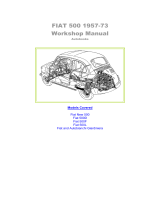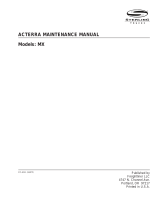Page is loading ...

ISTRUZIONI D’USO E DI INSTALLAZIONE
INSTALLATION AND USER’S MANUAL
INSTRUCTIONS D’UTILISATION ET D’INSTALLATION
INSTALLATIONS-UND GEBRAUCHSANLEITUNG
INSTRUCCIONES DE USO Y DE INSTALACION
INSTRUÇÕES DE USO E DE INSTALAÇÃO
D811513 ver. 03 08-11-07
I
GB
F
D
E
P
CASSA DI FONDAZIONE PORTANTE PER SUB 90°
FONDATION CASE FOR SUB 90°
CAISSE DE FONDATION PORTEUSE POUR SUB 90°
TRAGFÄHIGES FUNDAMENTGEHÄUSE SUB 90°
CAJA DE CIMENTACION DE SUSTENTACION PARA SUB 90°
CAIXA DE FUNDAÇÃO PORTANTE PARA SUB 90°
FCS
Via Lago di Vico, 44
36015 Schio (VI)
Tel.naz. 0445 696511
Tel.int. +39 0445 696533
Fax 0445 696522
Internet: www.bft.it
E-mail: [email protected]
8
027908 2 9 7 2 9 7

GB
This product is supplied with a “Warnings” leaflet and an
“Instruction Manual”. These should both be read carefully
as they provide important information about safety, installation,
operation and maintenance.
1) DIMENSIONS (FIG.1)
2) FOUNDATION CASE INSTALLATION
Make a hole in the ground at the foot of the gatepost which is large
enough to house the FCS case (Fig.1). Make sure that water is always
drained away adequately. Make a concrete base on which the case can
rest so that adjustment can be carried out (Fig.2). The case should be
positioned so that the centre of the bushing is in a perfect line with the
hinge of the gate leaf. In order to prevent any unwanted cement from
penetrating inside, proceed to close all gaps and unused holes.
Check the axis of the gate leaf with a plumb line and both sides of the
box with a level (Fig.2). Position the drain for the water and the race-
ways for connections. In order to prevent any unwanted cement from
penetrating inside, proceed to close all gaps and unused holes. Fill the
hole. In order to prevent curving of the foundation case walls during
casting, we recommend to insert a wooden strut in between.
N.B. The edge of the case should protrude by about 8-10 mm from
ground level so that the cover can be fitted correctly.
3) GATE LEAF ASSEMBLY
Once the concrete has hardened, the leaves of the gate can be as-
sembled as follows: Grease the bushing and brass carefully.
3.1) Right leaf (seen from the inside - Fig.4)
-
Insert the bush “Y” into the appropriate seat (Fig.4A).
- Rest the gate leaf on the bushing in GATE CLOSED position, check
the alignment of the leaf (bushing - leaf hinge) as when positioning
the case.
-
Accurately line the bushing notch up with the notch “DX” in the
case.
-
Weld the bushing securely to the leaf.
3.2) Left leaf (seen from the inside - Fig.4)
-
Carry out all the operations as in point 3.1, aligning however the
bush notch with the “SX” notch on the box.
4) CONTROLLER ASSEMBLY
-
Fit the grooved joint onto to motor shaft (Fig.4B).
- Fit the raiser cone using the two three-lobed screws M3x8 and ap
-
propriate washers (Fig.3).
-
Release the operator using the appropriate triangular key and rotate
the output shaft in the leaf closing direction along the entire stroke.
To rotate the output driving shaft, you can use an adjustable span-
ner to be placed on the hollow of the grooved joint. Fig.4B shows the
different positions of the splined joint after it has been mounted on
the operator, depending on whether the leaf is mounted on the right
(DX) or on the left (SX).
-
Rotate the splined joint tooth towards the opening direction, until it
is brought parallel with the operator (Fig.4C).
-
Abundantly grease the threaded holes in the bottom of the case.
- Open the leaf so as to have enough room to insert the operator (Fig.
5/A).
-
Start to screw dowel M12x20 into the respective threaded hole
found in the grooved joint (Fig.4C).
-
Insert the operator following the movements indicated in figure 5,
until the lower plate becomes inserted between the walls of the
case, and bring the operator to the intermediate position shown in
Fig. 5/C.
-
Close the leaf until the bush notch is located in the centre, i.e. half-
way between the right and left marks. In this position, the joint tooth
can be inserted in the bush; in the case where the bush cannot be
inserted straight away, the leaf must be moved further.
-
Slightly lift the operator by holding it from the front (Fig.5/D) and
push it against the stop plate as in Fig. 5/E. You can be sure of cor-
rect positioning when the holes “K” in the plate are aligned with the
nut welded on the bottom of the case (Fig. 5/F).
-
Now screw dowel M12x20 in fully.
- Insert the M12x130 screws into holes “K” and tighten them (Fig.6).
- Close and fix the cap with the 2 short self-threading screws, then fix
the cover with the 2 long screws. Connect the operator and test the
system.
2 - FCS - Ver. 03
D811513_03

200
290
12
30
221
56
200
392
283
ø65
221
94
400
34,5
120
Livello pavimento
Ground level
Niveau du sol
Bodenhöhe
Nivel pavimentacion
Nível do pavimento
8÷10 mm
FIG.1
FIG.2
FIG.3
FCS - Ver. 03 - 5
D811513_03

DX
DX
SX
Destra / Right
Droite / Rechts
Derecha / Direita
DX:
Sinistra / Left
Gauche / Links
Izquierda / Esquerda
SX:
Fig.4
Fig. 4B
Fig. 4C
SX
Fig. 4A
Y
M12x20
6 - FCS - Ver. 03
D811513_03

Fig. 6
Fig. 5
M12 x 130
1
K
2
A
B
E
D
F
C
K
FCS - Ver. 03 - 7
D811513_03

/



